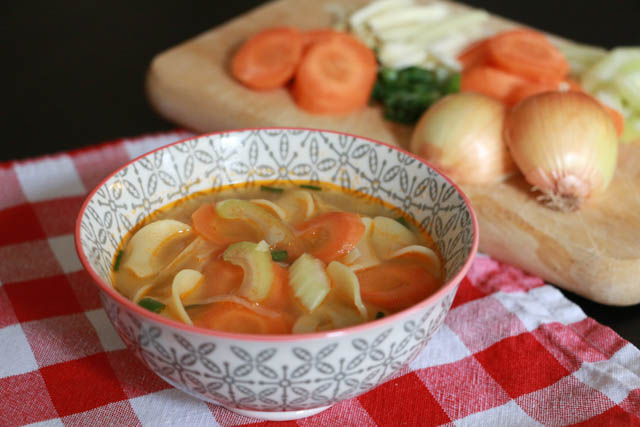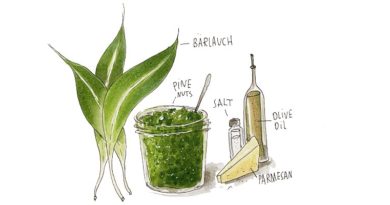Glorious Bone Broth
My elderly neighbor recently asked me to make her a soup, the type of chicken soup her mother made for her as a child in the 1930s – chicken soup made from bone broth and vegetables. I was delighted to see the sparkle in her eyes return after she had been consuming the soup for two days. Is it true that chicken broth can heal, or is that just an old wives’ tale?
Browsing through Fannie Farmer’s cookbook (1896) and Isabella Beeton’s Book of Household Management (1861), one finds recipes on what to feed the frail and weak, and these recipes are often based on bone broth.
In Chinese custom, chicken broth is highly prized as chicken essence. During the month-long postpartum confinement period, Chinese mothers drink chicken essence daily. Asian chicken broth is usually enhanced with medicinal plants and spices. Chicken essence in traditional Chinese medicine is the “yin tonic” for burnout; it nourishes the kidneys and builds the blood. Thus it is not surprising that most of the chicken feet from the American poultry industry are shipped to China, where they are used to make chicken essence.
Chicken soup is also known as “Jewish penicillin,” because Jewish mothers and grandmothers have a reputation for offering it as a remedy for colds, flus, and other illnesses. “A Jewish woman had two chickens. One got sick, so the woman made chicken soup out of the other one to help the sick one get well,” joked comedian Henny Youngman.
In the 1930s, Dr. Weston Price travelled around the world documenting the lifestyle of communities where the people were not yet eating what he called the “displacing food of modern commerce.” In Switzerland, he studied the isolated Swiss community in the Lötschental valley. He documented that the primary diet, particularly that of growing children, consists of raw milk, butter, raw milk cheese from cows grazing on lush grass, and rye bread from rye grown in the valley. They also ate meat once a week and used all the parts of the animal carcass to make bone broth. This broth, simmering in a cauldron all day, was consumed year round. Another observation that Dr. Price made was that both adults and children had broad, well-developed faces and palates, good dispositions and sturdy bodies, and healthy and straight teeth. It is no wonder that the young men from this valley are sought after for jobs in the Pope’s Swiss Guard.
Traditionally, nourishing broth is a basic remedy all around the world. In fact, we can find sayings or proverbs associated with it in all cultures. Below are several of these:
“The soup cost more than the meat.” (Hungarian proverb)
“The spoon does not know the taste of soup, nor a learned fool the taste of wisdom.” (Welsh expression)
“Soup makes the soldier.” (French proverb)
“One who has been burnt by soup begins to blow on the yogurt.” (Arab expression)
“Of soup and love, the first is best.” (Spanish proverb)
“Eat soup first and eat it last, and live to till a hundred years be passed.” (French proverb)
“Between the hand and mouth, the soup is split.” (Italian proverb)
Is broth a magic elixir? Is it an anti-aging remedy? Will broth hold my body together and keep my skin supple? Will broth keep my joints lubricated till I am a hundred years young? Will broth strengthen my bones and teeth? Is broth the much-needed nutritional support that will shift my gears from survive to thrive?
Science has now validated what our mothers and grandmothers knew about the cure-all properties of a good bone broth: it is nourishing, warm, soothing and healing for body, mind, and soul. Studies are showing that broth will boost immunity, alleviate cold and bronchitis, fight inflammation, strengthen bones and teeth, and improve mental health. Broth is highly nutritious in compounds like protein, peptides, minerals, trace elements and gelatin. It also provides a source of minerals and other bioactive compounds that are much needed for our stressful lives, to nourish our blood, to care for our connective tissues and to boost our immune system.
In our hectic lives, slaving over the stove may be the last thing we want to do. But think of it as a labor of love for those dearest in your life. Let’s revive old food traditions and spread good health to all around us, to our own children and to friends and neighbors who may also be far from family who would normally care for them in sickness and old age. Particularly look for elderly neighbors in your neighborhood and share with them a bowl of chicken soup with homemade broth. It is wonderful to sooth the aches and pains of the joints and a lovely gesture of love and friendship.
Recipe: Chicken Broth
Since this broth is meant to promote good health, it’s preferable to use organic ingredients if possible, for both the chicken and vegetables. You don’t have to roast the chicken first but I prefer the taste of the broth when the chicken is first roasted.
- 1 chicken
- 100g butter, melted
- 20g chives, diced
- 20g parsley, diced
- 6 cloves garlic
- 500g vegetables, roughly cut. I typically use 2 onions or leeks, 6 carrots, celery leaves, ginger slices, a few crushed cloves of garlic
- 4 bay leaves
- 1 TB peppercorns
- 2 tablespoons apple cider vinegar
- Roast the chicken. Preheat the oven to 150°C. Salt and pepper the chicken. Melt the butter and stir in diced chives and parsley. Rub the butter mixture all over the chicken. Place chicken on a roasting pan and place in oven. Roast the chicken for 1½ to 2 hours, until meat is well cooked and juices are flowing. During the last 20 minutes, turn the heat up to 200C to crisp the skin. Watch the oven carefully during this time to make sure the chicken skin doesn’t burn.
- Remove the meat and soak the bones and scraps. Place the roasted chicken in a big pot, so all the juices from the chicken will be saved as you cut up the chicken. Remove the cooked meat and set aside; you can use this meat for the chicken soup later. Roughly break apart the bones and leave all the bones, skin, and remaining meat scraps in the big pot. Cover the chicken with cold water, about 1-2 liters. Add the cider vinegar and leave for about an hour to soak. The cider vinegar will acidify the water and help leach the minerals out from the bones.
- Simmer the broth. Add the vegetables, bay leaves, and peppercorns to the pot, cover with a lid, and cook on the lowest heat for at least 3 hours or longer, up to 12 hours. Check water level occasionally; if it has reduced too much so that the solids are exposed, add a little water as necessary.
- Strain broth and store. Pour the finished broth through a strainer into another bowl or pot. Discard solids. Broth can be refrigerated for three days, after which it should be frozen for longer storage.
You can eat the broth plain but typically I use it to make a chicken vegetable soup. Simply simmer diced vegetables in the strained broth until tender (about 20-30 mins), add the cooked chicken, season salt and pepper, and serve.
Bon appetit!
Text and pictures by Angela Morris
Angela is an Australian mum and has been living in Switzerland for many years. She has two fast-growing young boys and is passionate about feeding them (and everyone else) wholesome and nutritious food. She strongly believes that nature has provided all that we need to heal our body, mind, and soul.




